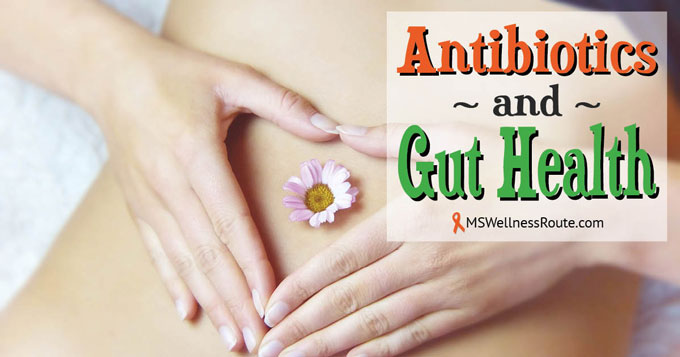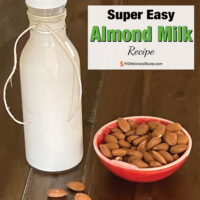Last Updated on December 5, 2023 by Cathy

There’s been a lot of news lately linking poor gut health with multiple sclerosis (MS). Our guts contain trillions of bacteria, viruses, and fungi. When it gets out of balance it can lead to diseases such as MS. Researchers discovered people with MS have different levels of bacteria than healthy people. In other words, they are lacking in good gut bacteria.
The number one reason gut bacteria gets out of balance is from antibiotics. Poor lifestyle habits such as diet and smoking also contribute to poor gut health. Researchers are currently looking into probiotics as a future therapy for people with MS. At the bottom of this post you can find a two-day menu plan for gut health.
Antibiotics
My genetics show I’m predisposed to MS, I have a three times higher risk. But, I believe antibiotics were my trigger to MS. You can see my DNA result in the photo below.

I was also your typical kid eating processed foods filled with hidden sugars. I craved sugar and high carbohydrates. Carbohydrates break down into sugar. That’s why diabetes counts carbs at each meal to control their blood sugar. Plus, I never ate fermented foods or took a probiotic supplement to add good bacteria to my gut.
The Standard American Diet (SAD) is mostly processed foods. Which is full of sugar and preservatives. It’s missing the good bacteria found in real fermented foods, not processed foods. Yes, yogurt is healthy. But most processed yogurts don’t have any living good bacteria left.
Challenge and Opportunity
I was recently put back on antibiotics due to an eye infection. I’d been working hard to build up my good bacteria and didn’t want to go backward. So, I decided to look at this as a challenge and an opportunity.
Challenge – my challenge was keeping Candida from growing. I was already taking antifungals so I increased the amount I was taking each day. Making sure I didn’t take too much to avoid die-off. Plus, I doubled my probiotics to keep my good bacteria levels up.
Opportunity – having the antibiotics kill off the bad bacteria. This was my opportunity to increase my good bacteria. While the bad bacteria was being killed I was going to load up on good bacteria. What I eat and don’t eat after the antibiotics will have a huge impact on my gut health.
Quick Links to information in this post:
DNA Test for Multiple Sclerosis
How Antibiotics Cause Multiple Sclerosis
MS and Candida Overgrowth
How To Tell If You Have Candida
5 Steps to build good bacteria while on antibiotics:
1. Eat Fermented Foods
Eating a diverse range of fruits, vegetables, herbs, and spices is beneficial for overall health and well-being. While fermented foods can contribute to a healthy gut microbiome by providing probiotics, which are beneficial bacteria, a balanced diet that includes a variety of plant-based foods offers numerous advantages for your health.
Here are some reasons why consuming fruits, vegetables, herbs, and spices is essential:
- They are rich in essential vitamins, minerals, antioxidants, and fiber.
- Fruits and vegetables are excellent sources of dietary fiber.
- Plant foods are packed with antioxidants, which help neutralize harmful free radicals in the body.
- They have phytochemicals, which are natural compounds that have many health benefits.
- While fermented foods contribute probiotics to the gut, fruits and vegetables provide prebiotics, which are substances that nourish and support the growth of beneficial bacteria.
- A diet rich in fruits and vegetables is associated with weight management and lower calorie intake.
- Consuming a diet rich in fruits and vegetables is linked to a lower risk of cardiovascular diseases.
- Some fruits and vegetables, especially those rich in antioxidants like berries and leafy greens, have been associated with cognitive function and a reduced risk of age-related cognitive decline.
2. Feed the Probiotics
Prebiotic foods help feed the good bacteria, allowing them to populate in your gut. It’s important to eat a good balance of both probiotics and prebiotics to improve your gut health. There’s no need to buy an expensive supplement, so save your money and add these foods to your diet:
Prebiotic Foods:
- Apples
- Asparagus
- Bananas
- Chia seeds
- Garlic
- Ground flaxseeds
- Jerusalem artichoke
- Jicama
- Leeks
- Onions
- Seaweed
Purchase organic fruits and vegetables as much as possible. To avoid pesticides and possibly further damage to your gut. If cost is a problem at least buy organic if it shows up on the Dirty Dozen List. If you need help with a menu plan check the bottom of this post.
3. Avoid Sugar
For a month after the antibiotics, I’m going to avoid all sugars including most fruits. Sugar feeds Candida and promotes the growth of bad bacteria, which is exactly what I don’t want. Instead, I want to give my good bacteria a huge head start.
If you’re following a Candida diet don’t avoid all fruit. If you cut out all sugars and eat very few carbohydrates your body can slip into ketosis. The problem with this is studies show Candida also feeds on ketones. Since I’m eating very little fruit and fewer carbs I’m keeping track of my ketones.
My son is a type 1 diabetic so I already had the strips in my house. You can find ketone strips at your local pharmacy. You don’t need a prescription and they don’t cost that much money. My son’s endocrinologist recommends Bayer Ketostix. As you can see in the photo below I’m doing good staying out of ketosis.

Fruits low in sugar:
- Avocados
- Berries
- Grapefruit
- Green apples
- Green bananas
- Lemons
- Limes
4. Other Foods to Avoid
I’m going to follow the strict part of the Candida diet. Which is the first three months while your body is trying to get rid of a lot of toxins. Again, I want to do everything I can to get my good bacteria levels up high.
– Cacao/chocolate
– Caffeinated beverages
– Cashews – high mold content
– Kombucha- wild bacteria
– Mushrooms – it’s a fungus
– Pistachios- high mold content
– Pork – possible parasites
– Red meat – it can cause inflammation
– Shellfish – bottom feeders
– Tuna – high in mercury
– Vinegar – except raw unfiltered apple cider vinegar
5. Take Probiotic Supplements
While taking antibiotics you should also take a probiotic at a different time of day. For example, if you take the antibiotic first thing in the morning take the probiotic in the evening. This will help more of the live bacteria survive from the antibiotic.
Candida overgrowth is being killed off you want to replace it with probiotics. The more good bacteria in your gut the less chance of Candida overgrowth returning. It’s important to look for a good quality probiotic.
I’m currently taking a probiotic with 50 billion live cultures. So I take one a few hours after each antibiotic in the morning and again in the evening. I found a brand that has 200 billion and 10 strains so I’ll take that the week following my antibiotics. This should help restore my intestinal flora balance.
Antibiotics and Gut Health
Antibiotics aren’t always bad, they can be lifesaving. However, it’s essential to be mindful of the impact antibiotics can have on gut health. Medications can eliminate both harmful and beneficial bacteria in the digestive system. Avoid the antibiotics that aren’t necessary. Like in conventional meats, instead, buy organic meats without antibiotics. Load up on probiotics and prebiotics to build up your good bacteria so your gut and health can flourish.
Get Your Two-Day Menu Plan for Gut Health
Get the password for the library with my Two Day Menu Plan for Gut Health interactive PDF here by filling out this form:
Want to remember this? Pin this to your favorite Pinterest board!

Antibiotics and Gut Health





